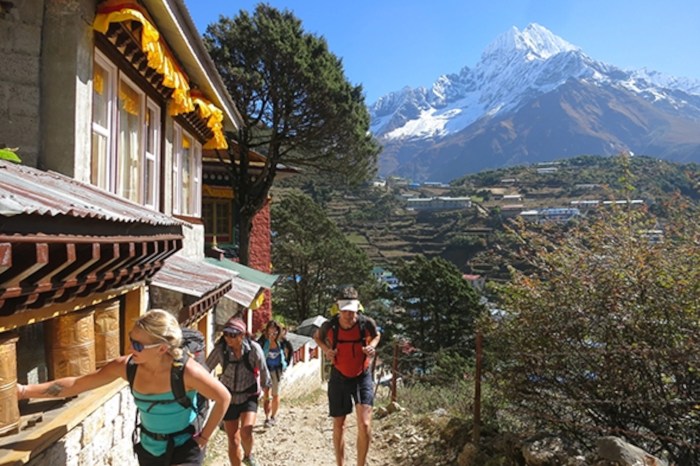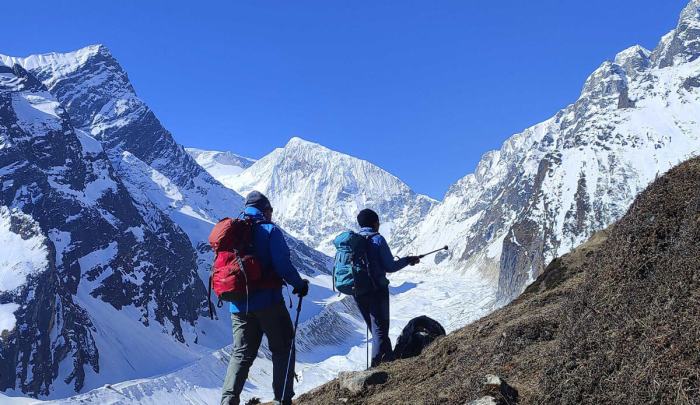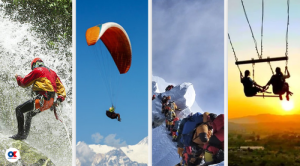
Immerse yourself in the majestic beauty of the Himalayas with the exhilarating experience of trekking. From challenging trails to breathtaking views, this guide will take you on a journey like no other.
Discover the allure of trekking in one of the world’s most iconic mountain ranges and embark on an unforgettable adventure filled with nature’s wonders and personal triumphs.
Overview of Trekking in the Himalayas
Trekking in the Himalayas offers a unique combination of breathtaking natural beauty and thrilling challenges. The towering peaks, lush valleys, and diverse landscapes make it a dream destination for adventure enthusiasts around the world.The Himalayas hold great significance as a trekking destination due to their majestic mountains, rich cultural heritage, and the opportunity to connect with nature on a profound level.
Trekking in this region not only provides a physical challenge but also a spiritual journey for many.
Popular Trekking Routes and Trails
- The Everest Base Camp Trek: One of the most iconic treks in the world, offering stunning views of Mount Everest and the Khumbu region.
- The Annapurna Circuit: Known for its varied landscapes, from subtropical forests to high-altitude desert, and panoramic views of the Annapurna and Dhaulagiri ranges.
- Langtang Valley Trek: A less crowded but equally beautiful trek, with views of snow-capped peaks, serene lakes, and traditional Tamang villages.
Best Time of Year for Trekking
Trekking in the Himalayas is best during the pre-monsoon (spring) and post-monsoon (autumn) seasons, which are generally from March to May and September to November respectively. During these times, the weather is more stable, the skies are clearer, and the views are spectacular. It is important to avoid the monsoon season (June to August) due to heavy rainfall and the winter months (December to February) when many high-altitude trails are snow-covered and difficult to navigate.
Family Travel
Trekking in the Himalayas can be a wonderful experience for families looking to bond and create lasting memories together. The majestic mountains, serene landscapes, and unique culture of the region offer a perfect setting for an unforgettable family adventure.
Feasibility of Trekking with Family
Trekking in the Himalayas with family members is definitely feasible, but it requires careful planning and consideration of everyone’s physical abilities and comfort levels. It’s important to choose a trekking route that is suitable for all family members, including children and elderly members. Additionally, make sure to acclimatize properly to the altitude and pack essentials like appropriate clothing, first aid kit, and snacks.
Tips for Families Planning a Trekking Adventure
- Start with shorter and easier treks to gauge everyone’s interest and capabilities.
- Choose a reputable trekking agency that has experience in organizing family-friendly treks.
- Involve children in the planning process and educate them about the trekking experience.
- Stay flexible with your itinerary to accommodate any unexpected changes or rest days.
- Encourage open communication and support among family members throughout the trek.
Family-Friendly Trekking Routes and Accommodations
- The Annapurna Circuit in Nepal is a popular family-friendly trek with stunning views and comfortable teahouse accommodations along the way.
- The Langtang Valley trek offers a relatively easier terrain and opportunities to interact with local communities.
- In Bhutan, the Druk Path Trek is suitable for families with older children, showcasing the country’s pristine landscapes and cultural heritage.
Benefits of Family Bonding through Trekking
Trekking in the Himalayas as a family can strengthen bonds and create shared memories that will last a lifetime. It provides an opportunity for family members to disconnect from their daily routines, work together towards a common goal, and support each other through challenges. The sense of accomplishment and the beauty of the natural surroundings can deepen the connections within the family and foster a spirit of adventure and exploration.
Romantic Getaways
Trekking in the Himalayas can offer a truly romantic experience for couples looking to escape into the serene landscapes and majestic mountains. The breathtaking views, peaceful surroundings, and sense of adventure can create unforgettable moments for partners seeking a romantic getaway.
Romantic Spots and Viewpoints
- One of the most romantic spots along popular trekking routes in the Himalayas is the Everest Base Camp. Watching the sunrise over Mount Everest with your loved one can be a magical experience.
- The Annapurna Circuit also offers stunning viewpoints like Poon Hill, where couples can witness the sunrise over the Annapurna mountain range, creating a romantic atmosphere.
- Langtang Valley trek is another romantic getaway with its picturesque landscapes, tranquil valleys, and close-up views of snow-capped peaks, providing couples with a perfect setting for romance.
Couples’ Experiences
- A couple from France shared their experience of trekking in the Himalayas, describing how the challenging trails, cozy tea houses, and starlit nights brought them closer together and strengthened their bond.
- An adventurous pair from the USA recounted their romantic escape in the Himalayas, where they hiked hand in hand, enjoyed quiet moments by mountain lakes, and stargazed under clear night skies, making memories to last a lifetime.
Romantic Escape in the Himalayan Landscapes
Imagine a romantic escape amidst the serene Himalayan landscapes, where you and your partner can disconnect from the hustle and bustle of daily life, immerse yourselves in nature’s beauty, and create unforgettable memories together. Whether it’s sharing a warm cup of tea in a cozy tea house, watching the sunset over the mountains, or simply holding hands while trekking through breathtaking valleys, the Himalayas provide the perfect backdrop for a romantic adventure.
Wellness Retreats
Trekking in the Himalayas offers not only physical challenges but also opportunities for mental and emotional rejuvenation through wellness retreats. Combining trekking with wellness activities can provide a holistic experience for travelers looking to enhance their overall well-being.
Benefits of Trekking in a Wellness Retreat Setting
- Improved mental health: Trekking in the serene and breathtaking Himalayan landscapes can help reduce stress, anxiety, and improve overall mental well-being.
- Physical fitness: The challenging terrain of the Himalayas offers a great workout for the body, helping in improving cardiovascular health and stamina.
- Connection with nature: Being surrounded by the majestic mountains and lush greenery can have a calming effect on the mind and soul, promoting mindfulness and inner peace.
- Detox from technology: Disconnecting from the digital world during a trekking expedition can help in reducing screen time and promoting a healthier relationship with technology.
Popular Wellness Retreat Centers in the Himalayas
- Ananda in the Himalayas: Located in Uttarakhand, this luxury wellness retreat offers a range of holistic therapies, yoga sessions, and spa treatments amidst the Himalayan foothills.
- Vana Retreat: Situated in Dehradun, Vana Retreat is known for its focus on wellness, mindfulness, and sustainable living practices, making it an ideal place for a wellness retreat combined with trekking.
- Himalayan Iyengar Yoga Centre: Nestled in Dharamshala, this center offers yoga retreats combined with trekking experiences in the picturesque Himalayan region.
Tips for Travelers Seeking Rejuvenation through Trekking and Wellness
- Pack light and carry essential items for both trekking and wellness activities.
- Stay hydrated and eat nutritious meals to fuel your body for the trekking challenges.
- Practice mindfulness and meditation to fully immerse yourself in the natural surroundings during the trek.
- Listen to your body and take breaks when needed to avoid overexertion.
Beach Vacations

Beach vacations offer a completely different experience compared to trekking adventures in the Himalayas. While the mountains provide a rugged and challenging terrain, beaches offer relaxation and tranquility by the sea.
Comparison of Beach Vacations and Trekking Adventures
Beach vacations are known for their laid-back atmosphere, warm weather, and water activities such as swimming, snorkeling, and sunbathing. On the other hand, trekking in the Himalayas involves physical challenges, breathtaking views, and a sense of accomplishment reaching high altitudes.
Appeal of Himalayan Treks for Beach Holiday Travelers
Travelers accustomed to beach holidays may find the allure of a Himalayan trek in the sense of adventure, exploration of nature, and a break from the typical beach resort experience. The opportunity to disconnect from technology and immerse in the mountains can be a refreshing change.
Trekking and Beach Vacation Combo
Combining a trekking adventure in the Himalayas with a beach vacation can offer the best of both worlds. Travelers can start with an exhilarating trek in the mountains, followed by relaxing days on the beach to unwind and rejuvenate. This combination allows for a diverse travel experience.
Unique Experiences Offered
Beach vacations provide opportunities for water sports, beachside relaxation, and vibrant nightlife, while trekking adventures in the Himalayas offer physical challenges, cultural immersion, and stunning natural beauty. Both types of vacations cater to different preferences and interests, ensuring a memorable travel experience.
Safari Adventures

When comparing safari adventures to trekking in the Himalayas, one key difference lies in the focus of the experience. While trekking in the Himalayas involves hiking through mountainous terrain and immersing oneself in the natural beauty of the region, safari adventures typically revolve around observing and interacting with wildlife in their natural habitats.
Wildlife Encounters in the Himalayas
During a trek in the Himalayas, travelers have the opportunity to encounter a variety of unique wildlife species, including snow leopards, Himalayan blue sheep, musk deer, and various bird species. These encounters provide a thrilling and unforgettable experience for nature enthusiasts.
Travelers’ Stories
- One traveler shared their experience of combining a safari adventure in the jungles of Nepal with a trek to Everest Base Camp. They described the contrast between the lush greenery of the jungle and the stark beauty of the Himalayan landscape.
- Another traveler recounted their journey through the forests of Bhutan, where they spotted rare species such as the red panda and takin during their trek.
Adrenaline Rush vs. Physical Challenges
While safaris offer the adrenaline rush of close wildlife encounters and the thrill of spotting elusive species, trekking in the Himalayas presents its own set of challenges, including high altitudes, steep terrain, and long distances to cover. Both experiences provide a sense of adventure and excitement, albeit in different ways.
Mountain Trekking
Mountain trekking in the Himalayas offers a unique and challenging experience for adventure enthusiasts. The rugged terrain, high altitudes, and stunning landscapes make it a popular destination for trekkers seeking an adrenaline rush and a connection with nature.
Comparison with Other Mountain Ranges
When comparing mountain trekking in the Himalayas with other mountain ranges around the world, the Himalayas stand out for their sheer size, diverse ecosystems, and cultural richness. While the Alps in Europe offer well-marked trails and comfortable amenities, the Andes in South America provide a mix of challenging peaks and ancient civilizations. However, the Himalayas offer a unique blend of spirituality, remote wilderness, and technical challenges that set them apart from other regions.
Technical Skills and Gear
To undertake mountain trekking in the Himalayas, trekkers need to be well-prepared with the right gear and technical skills. Essential items include sturdy hiking boots, warm clothing, a reliable backpack, a tent, sleeping bag, and trekking poles. Additionally, trekkers should have experience in navigating rough terrain, acclimatizing to high altitudes, and managing emergency situations. Training in basic first aid and wilderness survival can also be beneficial for a safe trekking experience.
Experiences of Extreme Mountain Treks
Experiencing extreme mountain treks in the Himalayas can be both physically demanding and spiritually rewarding. Treks to high-altitude passes like Thorong La in the Annapurna Circuit or Everest Base Camp in the Khumbu region require stamina, mental resilience, and a sense of adventure. The breathtaking panoramas, close encounters with local cultures, and the sense of achievement upon reaching a summit make these extreme treks unforgettable for those who dare to embark on the journey.
Urban Exploration
Urban exploration in the Himalayan region offers a stark contrast to the natural landscapes experienced during a trek. While trekking immerses you in the pristine beauty of mountains, forests, and rivers, urban exploration introduces you to the hustle and bustle of cities, with their vibrant cultures, historical sites, and modern amenities.
Cities Near the Himalayas
- Kathmandu, Nepal: Known for its ancient temples, vibrant markets, and rich cultural heritage, Kathmandu serves as a popular base camp for trekkers heading to the Himalayas.
- Thimphu, Bhutan: The capital city of Bhutan, Thimphu offers a blend of traditional Bhutanese architecture and modern developments, providing a unique urban experience in the Himalayan region.
- Leh, India: Nestled in the Ladakh region, Leh is a picturesque city with monasteries, palaces, and markets, making it a great place to explore after a trek in the Himalayas.
Recommendations for Urban Exploration
- Visit Durbar Square in Kathmandu to admire its ancient temples and palaces.
- Explore the National Folk Heritage Museum in Thimphu to learn about Bhutanese culture and traditions.
- Stroll through the markets of Leh to shop for local handicrafts and souvenirs.
Road Trips
Road trips can be a fantastic addition to a Himalayan trekking itinerary, offering travelers the opportunity to explore the stunning scenery and unique culture of the region at their own pace. Whether driving to the starting point of a trek or simply taking a scenic drive through the mountains, road trips provide freedom and flexibility for travelers looking to immerse themselves in the beauty of the Himalayas.
Scenic Drives and Routes
- One of the most popular routes for road trips in the Himalayas is the Manali-Leh Highway, known for its breathtaking views of snow-capped peaks, rugged terrain, and high mountain passes.
- The Srinagar-Leh Highway is another iconic route that offers stunning vistas of the Himalayas, with picturesque lakes and valleys along the way.
- For those looking to explore the eastern Himalayas, the road from Darjeeling to Gangtok provides travelers with panoramic views of tea plantations, monasteries, and distant mountain ranges.
Road Trip Safety Tips
- Ensure your vehicle is in good condition before embarking on a road trip in the Himalayas, as roads can be challenging and remote.
- Carry plenty of water, snacks, and emergency supplies in case of unexpected delays or detours.
- Stay updated on weather conditions and road closures, especially during the monsoon season when landslides are common.
- Drive cautiously and be prepared for narrow roads, steep inclines, and sharp turns along mountain passes.
Freedom and Flexibility
Road trips offer travelers the freedom to explore off-the-beaten-path destinations in the Himalayas, stopping to take in stunning views, interact with local communities, and discover hidden gems along the way. Unlike organized tours, road trips allow for spontaneous detours and unplanned adventures, making them an ideal way to experience the diverse landscapes and cultures of the Himalayan region.
Cruise Travel
When it comes to travel experiences, cruise travel offers a stark contrast to the ruggedness of a Himalayan trek. While trekking in the Himalayas involves physical challenges and immersion in nature, cruise travel provides relaxation and luxury on the open seas.
Cruise Options with Himalayan Trekking Excursions
Some cruise itineraries now include options for travelers to combine their cruise experience with trekking excursions in the Himalayas. These unique offerings allow adventurers to enjoy both the comforts of a cruise ship and the thrill of exploring the mountainous terrain on foot.
Relaxation and Luxury vs. Physical Challenges
On a cruise, travelers can unwind in luxurious accommodations, indulge in gourmet dining, and enjoy onboard entertainment while sailing to exotic destinations. In contrast, trekking in the Himalayas requires physical endurance, mental fortitude, and a deep connection to the natural world.
Traveler Stories of Cruise and Trekking Adventures
Many travelers have shared their experiences of combining cruise travel with a trekking adventure in the Himalayas. These stories often highlight the unique contrast between the relaxation and luxury of a cruise ship and the raw beauty and challenges of trekking in the mountains.
Sports Tourism
Sports tourism plays a significant role in promoting trekking in the Himalayas by attracting adventure enthusiasts and fitness enthusiasts alike. Engaging in sports activities during a trekking adventure not only adds excitement and thrill but also enhances the overall experience by offering a unique way to explore the majestic Himalayan landscapes.
Sports Activities in Himalayan Trekking
- Mountaineering: Scaling peaks and summits in the Himalayas provides a challenging yet rewarding experience for adventure seekers.
- Rock Climbing: The rugged terrain of the Himalayas offers excellent opportunities for rock climbing enthusiasts to test their skills.
- Mountain Biking: Cycling through the scenic trails of the Himalayas is a thrilling way to explore the region’s natural beauty.
- White Water Rafting: Adventurous souls can enjoy the adrenaline rush of rafting in the Himalayan rivers, surrounded by breathtaking views.
Fitness Benefits of Sports Tourism in Himalayan Trekking
- Improved Cardiovascular Health: Engaging in sports activities during a Himalayan trek helps boost cardiovascular fitness and endurance.
- Enhanced Strength and Stamina: Activities like mountaineering and rock climbing contribute to building strength and endurance levels.
- Mental Well-being: The thrill of sports activities combined with the serene surroundings of the Himalayas can have a positive impact on mental well-being.
Sports Events in the Himalayan Region
- Everest Marathon: Known as the world’s highest marathon, this event takes place in the Everest region, attracting runners from around the globe.
- Himalayan Mountain Biking Championship: A thrilling competition that brings together mountain bikers to race through challenging Himalayan terrains.
- Himalayan Climbing Competitions: Various climbing competitions are organized in the Himalayas, showcasing the skills and determination of climbers.
Last Word
As you conclude this exploration of trekking in the Himalayas, envision the memories you’ll create, the challenges you’ll overcome, and the serenity you’ll find amidst these towering peaks. Prepare for an adventure of a lifetime.
Detailed FAQs
Is trekking in the Himalayas suitable for beginners?
While some routes are more challenging, there are beginner-friendly treks with stunning views that cater to all experience levels.
What should I pack for a trek in the Himalayas?
Essentials include sturdy hiking boots, warm clothing, a reliable backpack, water bottles, snacks, and a first aid kit.
Are permits required for trekking in the Himalayas?
Yes, certain areas may require permits which can be obtained through local authorities or trekking agencies.
Can I trek in the Himalayas during the monsoon season?
It’s not recommended due to risks of landslides and difficult trail conditions. The best time is usually during the spring and autumn months.





